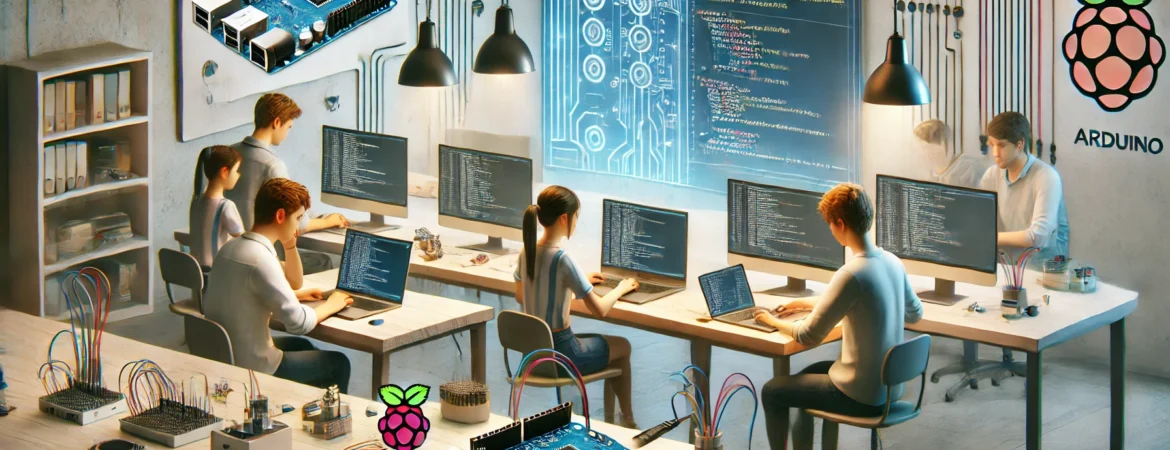1. What is a Microcontroller?
A microcontroller is a small, self-contained computing device designed to execute specific tasks within an embedded system. Unlike general-purpose computers, microcontrollers are optimized for controlling hardware components, processing input from sensors, and managing actuators like motors and LEDs.
Microcontrollers are widely used in robotics, automation, IoT (Internet of Things), and consumer electronics. They enable devices to operate independently with minimal external control, making them essential for smart technology development.
1.1. Key Features of Microcontrollers
- Compact and Integrated: Contains a CPU, RAM, storage, and input/output interfaces in one chip.
- Low Power Consumption: Optimized for battery-operated applications.
- Real-time Processing: Executes tasks instantly, making it ideal for automation.
- Interfacing with Sensors and Actuators: Reads input data from sensors and controls motors, displays, and other components.
- Cost-effective: Affordable compared to full-scale computing devices.
2. Introduction to Arduino
2.1. What is Arduino?
Arduino is an open-source microcontroller platform designed for beginners and professionals to build interactive electronic projects. It consists of both hardware (Arduino boards) and software (Arduino IDE).
2.2. Popular Arduino Boards
- Arduino Uno: The most common board for beginners.
- Arduino Mega: Offers more pins and memory for complex projects.
- Arduino Nano: A compact board for small-scale applications.
- Arduino Due: A high-performance board with a 32-bit processor.
2.3. Applications of Arduino
- Home automation systems.
- Robotics projects.
- Weather monitoring stations.
- IoT applications.
2.4. Example Code – Blinking an LED with Arduino
cppKopyalaDüzenleint led = 13;
void setup() {
pinMode(led, OUTPUT);
}
void loop() {
digitalWrite(led, HIGH);
delay(1000);
digitalWrite(led, LOW);
delay(1000);
}
This simple code makes an LED connected to pin 13 blink every second.
3. Introduction to Raspberry Pi
3.1. What is Raspberry Pi?
Raspberry Pi is a series of small, affordable, single-board computers designed for learning, coding, and electronics projects. Unlike Arduino, Raspberry Pi runs a full operating system (Raspberry Pi OS) and supports higher-level programming.
3.2. Popular Raspberry Pi Models
- Raspberry Pi 4 Model B: A powerful model with up to 8GB RAM.
- Raspberry Pi 3 Model B+: An older but widely used model.
- Raspberry Pi Zero: A compact, low-cost version for simple projects.
3.3. Applications of Raspberry Pi
- Home media centers.
- AI and machine learning projects.
- Web servers.
- IoT applications.
3.4. Example Code – Blinking an LED with Raspberry Pi (Python)
pythonKopyalaDüzenleimport RPi.GPIO as GPIO
import time
led = 18
GPIO.setmode(GPIO.BCM)
GPIO.setup(led, GPIO.OUT)
while True:
GPIO.output(led, GPIO.HIGH)
time.sleep(1)
GPIO.output(led, GPIO.LOW)
time.sleep(1)
This Python code makes an LED connected to GPIO 18 blink every second.
4. Arduino vs. Raspberry Pi: Key Differences
| Feature | Arduino | Raspberry Pi |
|---|---|---|
| Type | Microcontroller | Single-board computer |
| Operating System | No OS, runs firmware | Runs Linux-based OS |
| Programming Language | C/C++ (Arduino IDE) | Python, Java, C++, etc. |
| Power Consumption | Low | Higher |
| Best For | Hardware control, real-time applications | Complex processing, networking, AI |
5. Conclusion
Microcontrollers like Arduino and Raspberry Pi play a vital role in embedded systems and IoT applications. While Arduino is great for real-time control of hardware, Raspberry Pi is more suitable for complex computing tasks. Understanding their differences and applications enables engineers and hobbyists to develop innovative projects in robotics, automation, and smart devices.
Mikrodenetleyiciye Giriş: Arduino, Raspberry Pi Gibi Cihazların Tanıtımı
1. Mikrodenetleyici Nedir?
Mikrodenetleyici, gömülü sistemlerde belirli görevleri yerine getirmek için tasarlanmış küçük ve bağımsız bir bilgisayar çipidir. Genel amaçlı bilgisayarlardan farklı olarak mikrodenetleyiciler, donanımı kontrol etmek, sensörlerden veri işlemek ve aktüatörleri yönetmek için optimize edilmiştir.
Mikrodenetleyiciler, robotik, otomasyon, IoT (Nesnelerin İnterneti) ve tüketici elektroniği gibi birçok alanda yaygın olarak kullanılır.
1.1. Mikrodenetleyicilerin Temel Özellikleri
- Kompakt ve Entegre: CPU, RAM, depolama ve giriş/çıkış birimlerini içerir.
- Düşük Güç Tüketimi: Pil ile çalışabilen cihazlar için uygundur.
- Gerçek Zamanlı İşleme: Komutları anında yerine getirir.
- Sensör ve Aktüatör Kontrolü: Sensörlerden veri alıp motorları ve ekranları kontrol eder.
- Ekonomik: Tam ölçekli bilgisayarlara kıyasla düşük maliyetlidir.
2. Arduino’ya Giriş
2.1. Arduino Nedir?
Arduino, elektronik projeler geliştirmek için kullanılan açık kaynaklı bir mikrodenetleyici platformudur. Arduino, donanım (Arduino kartları) ve yazılım (Arduino IDE) bileşenlerinden oluşur.
2.2. Popüler Arduino Kartları
- Arduino Uno: Başlangıç için en yaygın kullanılan modeldir.
- Arduino Mega: Daha fazla giriş/çıkış pinine sahiptir.
- Arduino Nano: Küçük boyutlu projeler için idealdir.
- Arduino Due: 32-bit işlemciye sahip yüksek performanslı bir modeldir.
2.3. Arduino Kullanım Alanları
- Akıllı ev sistemleri.
- Robotik projeler.
- Hava durumu istasyonları.
- IoT uygulamaları.
2.4. Örnek Kod – LED Yakıp Söndürme (Arduino)
cppKopyalaDüzenleint led = 13;
void setup() {
pinMode(led, OUTPUT);
}
void loop() {
digitalWrite(led, HIGH);
delay(1000);
digitalWrite(led, LOW);
delay(1000);
}
Bu kod, 13 numaralı pine bağlı LED’in her saniye yanıp sönmesini sağlar.
3. Raspberry Pi’ye Giriş
3.1. Raspberry Pi Nedir?
Raspberry Pi, öğrenme, kodlama ve elektronik projeleri için geliştirilmiş, uygun maliyetli ve küçük boyutlu bir tek kartlı bilgisayardır.
3.2. Popüler Raspberry Pi Modelleri
- Raspberry Pi 4 Model B: Güçlü işlemci ve 8GB’a kadar RAM desteği.
- Raspberry Pi 3 Model B+: Daha eski, ancak yaygın kullanılan bir model.
- Raspberry Pi Zero: Küçük ve düşük maliyetli bir versiyon.
3.3. Raspberry Pi Kullanım Alanları
- Ev medya merkezleri.
- Yapay zeka ve makine öğrenimi projeleri.
- Web sunucuları.
- IoT uygulamaları.
3.4. Örnek Kod – LED Yakıp Söndürme (Python & Raspberry Pi)
pythonKopyalaDüzenleimport RPi.GPIO as GPIO
import time
led = 18
GPIO.setmode(GPIO.BCM)
GPIO.setup(led, GPIO.OUT)
while True:
GPIO.output(led, GPIO.HIGH)
time.sleep(1)
GPIO.output(led, GPIO.LOW)
time.sleep(1)
Bu Python kodu, GPIO 18 pinine bağlı LED’in yanıp sönmesini sağlar.
4. Sonuç
Arduino ve Raspberry Pi, mikrodenetleyici ve gömülü sistemler dünyasında devrim yaratmıştır. Arduino, donanım kontrolü için idealken, Raspberry Pi daha karmaşık hesaplama işlemleri için uygundur. Bu cihazları öğrenmek, robotik ve otomasyon projeleri geliştirmek isteyenler için büyük bir avantaj sağlar.
